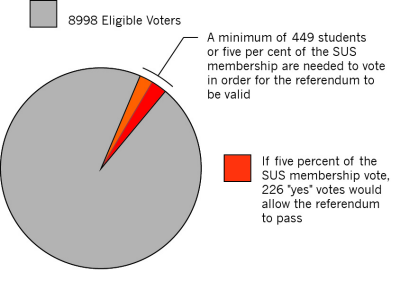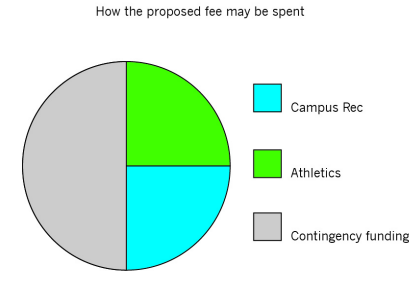By Sean Evans (The Cascade) – Email
Print Edition: March 14, 2012
The Student Union Society (SUS) will host a referendum between March 19 and 21. The question that students will be voting on is simple: “Do you support a student fee rated at three per cent of tuition, the proceeds of which will be earmarked for the sustainability of UFV varsity athletics, and the development of Intramural, Recreation, and Health & Wellness programs on campus?”
For many, the question comes as a shock, considering the size of the fee increase. For a full time fourth year student paying $2398 in tuition, that fee would be close to $72. That would make the Activity and Wellness fee larger than the U-Pass fee, the SUS fee, and the SUS building fee. For international students, the price would be even higher, as the fee is based on percentage of tuition. An International student, paying $6360 (numbers as of fall 2012), would be charged an extra $190.
One of the main proponents of the fee, SUS president Carlos Vidal, spoke with The Cascade. “One of our weak areas is the area of campus recreation and inter-mural sports,” Vidal pointed out. “It’s [Campus Rec] a lot of fun, it’s just really small. There is just no real core funding that is given to Campus Rec. And then Athletics was having some funding issues too, so seeing that there was a correlation between the two: students feelings toward Campus Rec and Athletics, they thought that this would be a great way to see if students would be willing to pay into both those programs. So, they came to us to help them with that.”
That is where the most perplexing part of this referendum came in – why is the University asking for funds from the Student Union Society? SUS Communications administrator, Jhim Burwell explained: “The reason it is being brought through SUS is that the Ministry of Education has put a hiatus on universities creating new fees.” Essentially, because the University can no longer raise or create fees, they are asking the students to implement one on themselves. Burwell continued, “Because we have an easy mechanism of polling the student body to find out if they’re willing to pay the fee, the University came to us to find that out. That is all this referendum is doing; gauging the willingness of the student body to pay that fee.”
The problem, however, has been that traditionally SUS referendums and elections have been plagued by voter apathy. The last referendum, which gave SUS permission to take out a $10 million mortgage, received only 599 “yes” votes and 351 “no” votes. According to SUS policy, only five per cent of the SUS membership has to vote for a referendum to pass.
By the estimate of Vidal, membership is “about 10,000 give or take, depending on the semester.” In reality, the numbers this semester are slightly lower: there are currently 8998 SUS members. As a result, approximately 449 would be required to vote in the referendum for it to pass successfully. In reality, just 226 members of the Student Union could vote in favour of the fee increase, and the referendum would pass (provided approximately 449 members voted in total) – resulting in a fee increase for the rest of the membership.
When questioned on this matter, Burwell simply stated, “Doesn’t matter. We’re brokering this referendum. It’s the Student Union members that are voting.” Vidal also weighed in on the matter: “We would love it if more people vote, but they don’t…If they don’t [vote], and then they’re upset with it, then that’s just one thing we’ll have to tell them later: ‘why didn’t you vote, if you’re upset with it?’”
The ability for a large turnout has been hindered, to a degree, as the voting period is unusually short – only three days. To put it in perspective, the 2012 SUS general election lasted seven days. When asked about this, Burwell simply stated that the length of the referendum was a decision made by the Athletic Department.
Fourth-year History student Rob Grant was divided on the issue: “I absolutely support varsity athletics and would love to see an expansion or even opening of ‘intramural, recreation, and health and wellness programs,’ but I would want to know how this money is being spent and why such a high per cent – why not two per cent? A lot of my friends struggle to make school payments as it is and I know that the increased cost (even something that may seem as meager as $75) is a lot of money to some people.”
Indeed, it is not clear exactly how this proposed fee will be spent. In a SUS press release on February 17, it stated that: “Specific percentages will be allocated to varsity athletics and campus recreation, and the lion’s share will go to contingency funding that will be used to make sure the UFV community has the resources to provide quality athletics and recreation programming into the future.” What those specific percentages will look like remains to be seen.
What was made clear, by both Vidal and Burwell, was that the funds will primarily be spent on Campus Rec and other SUS organized activities. “The percentages haven’t been decided yet, but I can tell you that we’re going to be fighting for Campus Rec to be a huge part of that fee,” said Vidal.
Vidal explained the process that would follow if the referendum passed. “If the student body votes that they want this fee. What will happen is the Student Union will have to sit down with the University and their representatives and essentially create a contract of how this money is going to be coming in through the SUS and how the SUS is going to disperse these funds to the various departments.”
“There will never be more money going to Athletics than Campus Rec, I can assure you that,” Vidal promised. Burwell continued, explaining that “the starting point is 25 per cent varsity, 25 per cent Campus Rec and 50 per cent into the contingency fund.” Burwell also explained what the contingency fund would be: “For example, if the varsity teams get into the postseason and that hasn’t been budgeted for. What would happen is the University would come to us and say ‘we need money out of the contingency fund’… and the board would decide.” So, while 50 per cent of the funds would be split between Campus Rec and varsity, the remaining 50 would be available to whomever needed it – contingent upon the approval of the board. Later, when asked why the Athletics department was so involved with the process of a SUS referendum, Burwell conceded that “we are administering the referendum itself, but in the end, the way that the money that comes in is going to be used, is going to be used by Athletics and by Student Life to provide programing for students.”
As the proposed fee would see capital upgrades to the Athletics programs, the issue has been promoted to student athletes and has been widely discussed by students in the kinesiology department. A member of the UFV Cascades Soccer team, Sasa Plavsic, commented on the promotion of the referendum to student athletes. “It was told to us by our coaches. They said there is a possibility this could happen and that this is what needs to happen for it to go through… The coaches encouraged us to vote; they didn’t tell us which way to vote. We could either vote yes or no. It’s completely up to us, because we have to pay for the fee.” While Plavsic said that no Kinesiology professors had brought the issue up in class, he stated that he “heard it being talked about in classes from a few different people. From Student Life, from athletes, just general population.”



